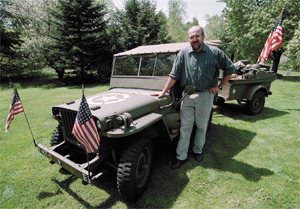Brunswick, Maine
Friday, May 25, 2001


WWII workhorse to be featured in Monday's parade
Sara Holt, Times Record; May 25, 2001
TOPSHAM ,MAINE - The 1942 military Ford Jeep
sitting
in Rene Bernier's yard is still a powerful vehicle. Never mind
that
its hardy gears can handle waist-deep mud or that its sturdy wheels can
climb up hills and over rocks with the determination of a mountain
goat.
It is capable of something more; capable of evoking the untold stories
and buried memories of World War II veterans when they see it for the
first
time in half a century.
"The veteran's response to
viewing
my vehicle and displays varies from excited tale-telling to somber
reflection,"
said Bernier, 46.
Having made its way from
the depths of a Bowdoinham barn into the light of day, the Jeep has
since
been restored single-handedly by Bernier to appear exactly as it once
did
in Fort Oglethorpe, Ga., where U.S. military forces used it to train
American
soldiers during World War II. At least, that's Bernier's theory,
judging by the closeness of the blue government numbering along one
side
to the numbers on another Jeep in a photograph he saw once.
The Jeep will be featured
prominently
in Monday's Topsham-Brunswick Memorial Day parade, where it will carry
World War II veteran Maj. Andrew Morin of Brunswick.
A Bowdoin College chemistry
professor, Bernier has restored six Jeeps in his Topsham home since
1974.
Ironically, no one in his immediate family served in World War II. But
a general love of Jeeps led him to begin restoring wartime vehicles.
He'll talk about how the U.S.
government first solicited the American Bantam Car Co. to design a
vehicle
to serve the armed forces, but "the government was afraid because it
was
just this little piddly car company in Pennsylvania. So it tried their
Jeep, took their plans and gave them to Ford and Willys. As a
concession,
the government then threw Bantam the bone and said, 'You can make the
trailers.'"
Bernier's Jeep will also pull
a military trailer made in 1945 in the parade. Bernier paid to take it
from its Topsham home, where it was sitting in the yard full of junk,
he
said, and restored it completely. Monday, it will display field gear
used
by soldiers in the war.
Bernier delights in showing
off the gadgetry aboard the vehicle; they thought of everything, he
said.
Special mirror and windshield coverings prevented the glass from
reflecting
at night when U.S. soldiers needed to pass through enemy territory
without
lights. The headlights manually pivot backwards to help soldiers do
engine
repairs in the dark, without adding the weight of a light under the
hood.
The large white star indicates the Allied forces.
Every detail had to be perfect
to win first prize in the Military Vehicle Preservation Association
East
Coast Rally in Aberdeen, Md., just two weeks ago. And after putting the
finishing touches on it last summer, Bernier also won first place for
"Best
Overall Individual Entry" in the Bath Heritage Days Parade.
He has stories to tell about
this one in particular, a favorite being having to call AAA to say he
couldn't
move it out of the Bowdoinham barn - never mind the fact that it hadn't
run in 26 years.
"The wheels wouldn't even
turn;
they just dragged," he said with a chuckle.
The Jeep belonged to Hal
Ahlers
of Bowdoinham, whose father bought it surplus around 1950. A family
heirloom
on which he and his siblings learned to drive, it ended up sitting in
his
barn, rusting away in Ahlers' adult years, said Bernier. "I went there
expecting a hunk of garbage, but it was just beautiful," he added. "It
didn't plow, it didn't pull stumps; it never got beat up."
For Bernier, there's nothing
better than getting a driving buddy, putting the top down, and tooling
along remote logging roads in Jackman with the sun on your back. "I can
easily drive 100 miles on it," he said. "Some guys think you're crazy,
but I just can't help myself."
Its uniqueness makes it all
the more an enjoyable ride; its aged canvas even smells military.
"You can't just buy one of
these
- you have to find it," he said. "The hunt is part of the fun. But
they're
getting thin. I keep hoping that one will turn up in a barn somewhere."
Though difficult to come
across
now, the Jeep is one of 500,000 churned out by American women on the
home
front during World War II, Bernier said. In the rush to bury the enemy
alive in as much equipment as possible, most vehicles were slapped
together,
sloppily painted and predicted to perform only 90 days.
Little did anyone project to
see - let alone drive - one almost 60 years later. "They weren't built
to last, but they just did," Bernier said.
"A lot of the veterans love
it. They see it and their eyes light up. It's more than just an antique
vehicle, you know. It's a piece of American history. It's the most
recognizable
vehicle, in every corner of the earth. Little kids who can't speak
English
see it and go, 'Jeep!' It represents how Americans pulled together to
win
that war."